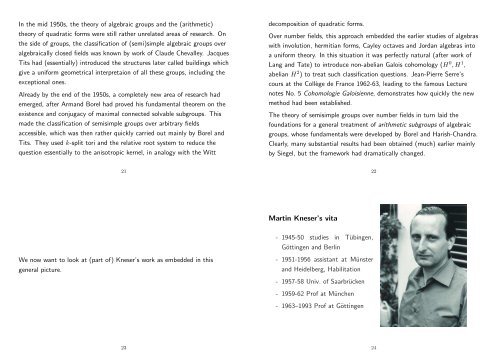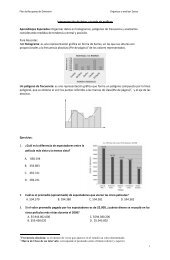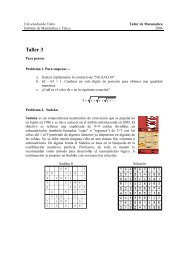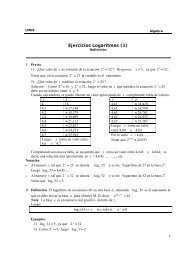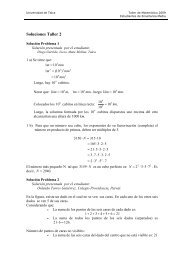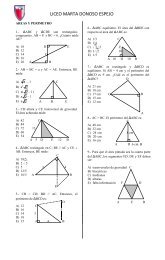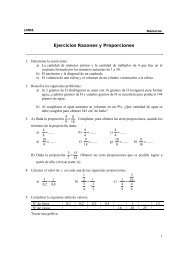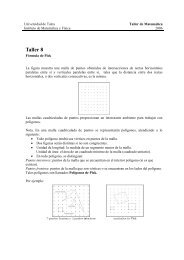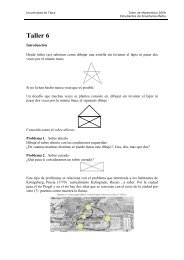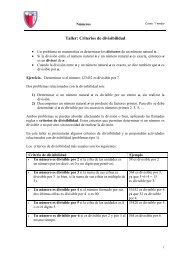Martin Kneser's work on quadratic forms and algebraic groups.
Martin Kneser's work on quadratic forms and algebraic groups.
Martin Kneser's work on quadratic forms and algebraic groups.
You also want an ePaper? Increase the reach of your titles
YUMPU automatically turns print PDFs into web optimized ePapers that Google loves.
In the mid 1950s, the theory of <strong>algebraic</strong> <strong>groups</strong> <strong>and</strong> the (arithmetic)theory of <strong>quadratic</strong> <strong>forms</strong> were still rather unrelated areas of research. Onthe side of <strong>groups</strong>, the classificati<strong>on</strong> of (semi)simple <strong>algebraic</strong> <strong>groups</strong> over<strong>algebraic</strong>ally closed fields was known by <str<strong>on</strong>g>work</str<strong>on</strong>g> of Claude Chevalley. JacquesTits had (essentially) introduced the structures later called buildings whichgive a uniform geometrical interpretai<strong>on</strong> of all these <strong>groups</strong>, including theexcepti<strong>on</strong>al <strong>on</strong>es.Already by the end of the 1950s, a completely new area of research hademerged, after Arm<strong>and</strong> Borel had proved his fundamental theorem <strong>on</strong> theexistence <strong>and</strong> c<strong>on</strong>jugacy of maximal c<strong>on</strong>nected solvable sub<strong>groups</strong>. Thismade the classificati<strong>on</strong> of semisimple <strong>groups</strong> over arbitrary fieldsaccessible, which was then rather quickly carried out mainly by Borel <strong>and</strong>Tits. They used k-split tori <strong>and</strong> the relative root system to reduce thequesti<strong>on</strong> essentially to the anisotropic kernel, in analogy with the Wittdecompositi<strong>on</strong> of <strong>quadratic</strong> <strong>forms</strong>.Over number fields, this approach embedded the earlier studies of algebraswith involuti<strong>on</strong>, hermitian <strong>forms</strong>, Cayley octaves <strong>and</strong> Jordan algebras intoa uniform theory. In this situati<strong>on</strong> it was perfectly natural (after <str<strong>on</strong>g>work</str<strong>on</strong>g> ofLang <strong>and</strong> Tate) to introduce n<strong>on</strong>-abelian Galois cohomology (H 0 ,H 1 ,abelian H 2 ) to treat such classificati<strong>on</strong> questi<strong>on</strong>s. Jean-Pierre Serre’scours at the Collège de France 1962-63, leading to the famous Lecturenotes No. 5 Cohomologie Galoisienne, dem<strong>on</strong>strates how quickly the newmethod had been established.The theory of semisimple <strong>groups</strong> over number fields in turn laid thefoundati<strong>on</strong>s for a general treatment of arithmetic sub<strong>groups</strong> of <strong>algebraic</strong><strong>groups</strong>, whose fundamentals were developed by Borel <strong>and</strong> Harish-Ch<strong>and</strong>ra.Clearly, many substantial results had been obtained (much) earlier mainlyby Siegel, but the frame<str<strong>on</strong>g>work</str<strong>on</strong>g> had dramatically changed.2122<str<strong>on</strong>g>Martin</str<strong>on</strong>g> Kneser’s vita- 1945-50 studies in Tübingen,Göttingen <strong>and</strong> BerlinWe now want to look at (part of) Kneser’s <str<strong>on</strong>g>work</str<strong>on</strong>g> as embedded in thisgeneral picture.- 1951-1956 assistant at Münster<strong>and</strong> Heidelberg, Habilitati<strong>on</strong>- 1957-58 Univ. of Saarbrücken- 1959-62 Prof at München- 1963–1993 Prof at Göttingen2324


